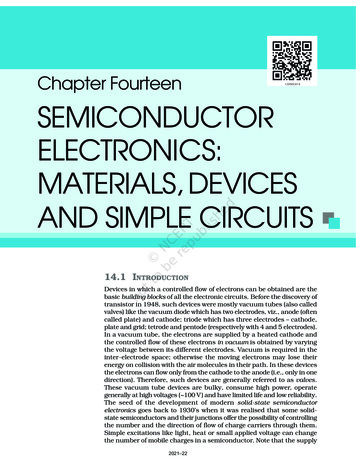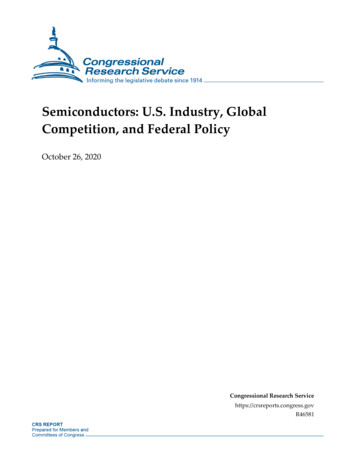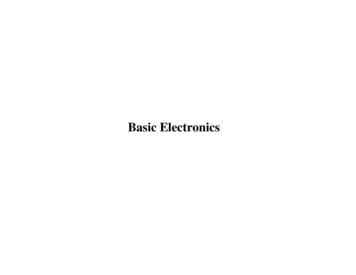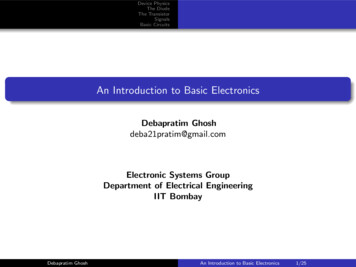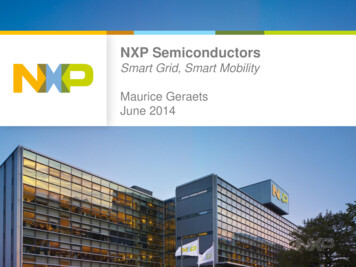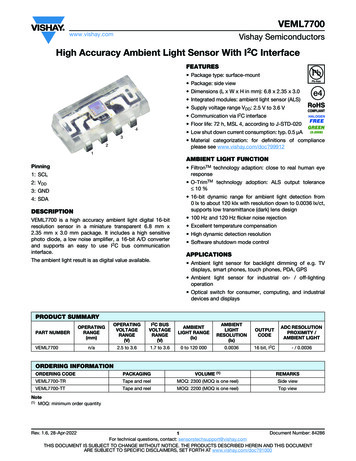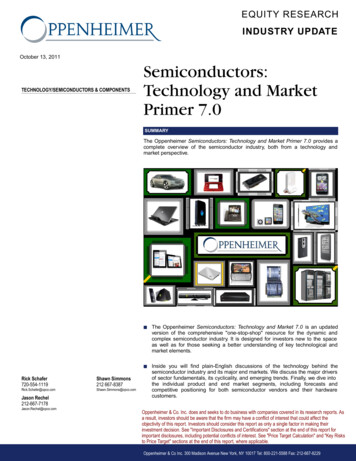
Transcription
EQUITY RESEARCHINDUSTRY UPDATEOctober 13, 2011TECHNOLOGY/SEMICONDUCTORS & COMPONENTSSemiconductors:Technology and MarketPrimer 7.0SUMMARYThe Oppenheimer Semiconductors: Technology and Market Primer 7.0 provides acomplete overview of the semiconductor industry, both from a technology andmarket perspective.Rick Schafer720-554-1119Shawn Simmons212 mJason Rechel212-667-7178Jason.Rechel@opco.com The Oppenheimer Semiconductors: Technology and Market 7.0 is an updatedversion of the comprehensive "one-stop-shop" resource for the dynamic andcomplex semiconductor industry. It is designed for investors new to the spaceas well as for those seeking a better understanding of key technological andmarket elements. Inside you will find plain-English discussions of the technology behind thesemiconductor industry and its major end markets. We discuss the major driversof sector fundamentals, its cyclicality, and emerging trends. Finally, we dive intothe individual product and end market segments, including forecasts andcompetitive positioning for both semiconductor vendors and their hardwarecustomers.Oppenheimer & Co. Inc. does and seeks to do business with companies covered in its research reports. Asa result, investors should be aware that the firm may have a conflict of interest that could affect theobjectivity of this report. Investors should consider this report as only a single factor in making theirinvestment decision. See "Important Disclosures and Certifications" section at the end of this report forimportant disclosures, including potential conflicts of interest. See "Price Target Calculation" and "Key Risksto Price Target" sections at the end of this report, where applicable.Oppenheimer & Co Inc. 300 Madison Avenue New York, NY 10017 Tel: 800-221-5588 Fax: 212-667-8229
TECHNOLOGYIntroductionThe Oppenheimer Semiconductors: Technology and Market Primer 7.0 is an updated version of thecomprehensive “one-stop-shop” resource for the dynamic and complex semiconductor industry we firstissued in June 2003 and updated in October 2004, December 2005, January 2007, January 2008, andDecember 2009.The report is targeted to those investors new to the sector as well as those looking for a comprehensiveresource to help them better understand key technological or market elements within the industry. Wealso suggest it as a “desk reference” for more experienced investors, as it has lots of forecast andmarket share data as well as in-depth discussions of many of the important trends affecting thesemiconductor industry.We start with basic semiconductor definitions and a simple review of manufacturing processes. Wethen discuss the semiconductor cycle and key fundamental indicators, and introduce some importantconcepts. We follow with a discussion of the major semiconductor product groups, including revenueforecasts and market share data. We then take a deep dive into the most important end marketsserved by the semiconductor industry, highlighting key players and company market shares for eachapplication.Product summaries cover analog, microcomponents, logic, memory and discrete devices. End marketsummaries cover computing, networking, telecom/datacom, wireless, digital consumer and automotivesemiconductors. We have also included a section on “emerging technologies,” where we briefly discussseven technologies that are just getting off the ground and that will be exciting to watch in 2011 andbeyond.Any comments that will help us make this a more successful document are welcome.Rick SchaferManaging DirectorShawn SimmonsAssociate DirectorJason RechelAssociate DirectorOppenheimer & Co.Semiconductor Equity ResearchNote on this version: All historical data on companies is current as of 2Q11; and industry sales, unit,and utilization data is also current up to July 2011. Market share data has been updated to reflect themost recent third-party sources and our internal estimates. All forecasts have been updated as well,and were also extended to 2015 (from 6.0’s 2013). There were also changes to formatting and thereport structure to make it more readable.2
TECHNOLOGYAcknowledgmentsWe would like to acknowledge the contributions of our research colleagues at Oppenheimer whose helpwas invaluable in the preparation of this report.Communication TechnologyIttai KidronGeorge IwanycEnterprise SoftwareBrad RebackArvind RajamohanCommunications and Infrastructure SoftwareShaul EyalHugh CunninghamEmerging Technology & ServicesAndrew UerkwitzSpecialty Semis & Enabling TechnologySrini SundararajanCommunications & Cloud ServicesTimothy HoranNed BaramovXavier OlaveInternetJason Helfstein3
TECHNOLOGYTable of ContentsSection I: Semiconductor Basics . 5Semiconductor Definitions . 6Semiconductor Device Structure . 8Semiconductor Devices in Systems . 9Semiconductor Manufacturing . 13CMOS . 20Lithography . 21Wafer Size . 24Manufacturing Strategies . 26Geographic Centers . 30Semiconductor Capital Equipment . 31Section II: The Semiconductor Market . 33Industry Basics . 34The Semiconductor Cycle. 39Fundamentals . 43Section III: Market Segments and Competitors . 54Semiconductor Device Types . 55Key Competitors . 62Section IV: Product Summary . 66Analog . 69Analog SLICs. 70Analog ASSPs . 72Microcomponents . 74Microprocessors . 75Microcontrollers . 78Digital Signal Processors . 81Digital Logic . 83Special Purpose Logic . 84Display Drivers . 86General Purpose Logic . 87ASICs . 88FPGAs/Programmable Logic Devices . 90Memory . 92DRAM . 93SRAM . 96NOR Flash . 98NAND Flash. 100Legacy Non-Volatile Memory. 102Discretes and Optoelectronics . 104Discretes . 105Sensors . 107Optoelectronics. 1084Section V: End Market Summary . 110Computing . 113PCs and Servers . 114PC Displays . 131Hard Disk Drives . 137Printers and Multi-Function Peripherals . 147Networking . 153Ethernet. 162Wireless LAN (802.11) . 170Bluetooth . 182Storage. 188Telecom/Datacom . 198Modems . 210PON . 224Communications Infrastructure . 231Wireless. 259Wireless Handsets . 264Wireless Infrastructure . 277WiMAX . 281LTE. 283Consumer Devices . 285Digital Set-Top Boxes. 286Digital TV. 294DVD Players and Recorders . 304Digital Cameras and Camcorders . 310Portable Media Players . 316Video Game Consoles . 321Flash Memory Cards . 330Automotive . 334Emerging Technologies . 339Tablet Computing . 340NFC . 342Connected Home . 343Picocells/Femtocells . 34440G & 100G . 345Ultrabooks . 346Context Aware Computing . 347
ctor BasicsBasicsThis section deals with the basics ofsemiconductorsTopics include:Semiconductor definitionsManufacturing- Semiconductor manufacturing process- CMOS- Lithography & Moore’s Law- Wafer Size- Manufacturing Strategies- Geographic Trends- Semiconductor Capital Equipment5
TECHNOLOGYSemiconductorSemiconductor DefinitionsDefinitionsA semiconductor is a solid-state substance that is halfwaybetween a conductor and an insulator. When charged, thesubstance becomes conductive; when the charge is eliminated, itloses its conductive status.By combining conductive material, semiconductor material, andinsulators in a pre-determined pattern, the movement ofelectricity can be precisely controlled. Semiconductors aretherefore ideal for building devices that control the operation ofelectronic equipment.A transistor is the basic elementused in building semiconductordevices. A transistor is fashionedfrom semiconductor material andacts as an on/off switch, whichopens and closes whenelectrically activated.Source: Computer Desktop Encyclopedia, Oppenheimer & Co.A semiconductor is a solid-state substance that is halfway between a conductor (which conducts electricity very well) and an insulator(which doesn’t conduct electricity at all). When charged with electricity or light, the substance becomes conductive, allowing electricityto flow through it. When that charge is eliminated, it loses its conductive status, and electricity cannot flow through. By combiningconductive material, semiconductor material, and insulators in a pre-determined pattern, the movement of electricity can be preciselycontrolled. Semiconductors are therefore ideal for building devices that control the operation of electronic equipment.The basic element used in constructing semiconductor devices is the transistor. A transistor is essentially a tiny on/off switch fashionedfrom semiconductor material, which sits between two charged regions known as a “source” and a “drain.” The switch can open andclose when electrically activated, allowing current to flow from source to drain (when the switch is closed or “on”), or blocking thecurrent’s passage (when the switch is open or “off”). A third region, the “trigger gate,” controls whether the switch is open or closed. Bymanipulating the gates within a semiconductor device, the system can accurately control the movement of electricity.6
TECHNOLOGYSemiconductorSemiconductor DefinitionsDefinitionsThe simplest semiconductor devices are comprised of asingle transistor; these are called discretes and areusually used to control the flow of signals and powerwithin a larger electronic device.More complex semiconductor devices are built bycombining multiple transistors and conductiveinterconnect material to form logic gates. These logicgates are arranged in a pre-defined pattern to performmore complex processing or storage functions. Thesedevices are called integrated circuits (ICs). The mostintegrated of these devices are known as system-on-achip devices, or SoCs.The simplest semiconductor devices are comprised of a single transistor. These devices are referred to as discretes, and they areused in all types of electronic equipment to control the flow of signals and power within a larger electronic system.When many transistors are combined, an integrated circuit is created that can be used to process or store data signals in an electricalformat. Engineers design pathways using transistors and conductive interconnect material set in logical arrangements (called “logicgates”) to perform specific functions, and these pathways become the circuit architecture etched onto the surface of the chip. Modernsemiconductor devices can perform a variety of different functions on a single chip, and many electronic devices are powered by highlyintegrated system-on-a-chip (SoC) devices.All electronic devices are built around semiconductors—transistors make up logic gates, logic gates make up circuits and circuits makeup electrical systems. Key end applications are computing, telecommunications, data networking, wireless communications, consumerelectronics, automobiles, industrial equipment, and aerospace/military.7
TECHNOLOGYSemiconductorSemiconductor DeviceDeviceStructureStructureSemiconductor devices contain a transistor array, which isetched onto a rectangular piece of silicon called a die. The dieis encased in a plastic or ceramic package, and tiny wirescalled wire bonding are used to connect the input/outputgates on the chip to the leads on the outside of the package.Typically, the cost split for a fully packaged IC is roughly 85%for the silicon and 15% for the package.P la s tic / C e r a m ic P a c k a g e a n dS u b s tr a teW ir eB o n d in gB a ck V ie wS ilic o nD iePackageLeadsF ro n t V ie wB a ck V ie wIn te rio r V ie wSource: Oppenheimer & Co.Typically, semiconductor devices are sold as standalone, fully functional packaged products that are ready to be implemented in anelectrical system. The transistor array (or in the case of a discrete, the lone transistor), which is etched onto a rectangular piece ofsilicon (called a “die”) during the wafer fabrication process, is housed in a plastic or ceramic package. Tiny wires called “wire bonding”are used to connect the input/output gates on the die to the leads on the package. The semiconductor device is snapped or solderedonto a printed circuit board, with the leads attached to conductive pathways along the board.For most semiconductor devices, the split in manufacturing value for a fully packaged semiconductor device is roughly 85% for thesilicon and 15% for the package, although this can vary with the type of package and complexity of the device. Lower end devicessuch as discretes can have 30% or more of its value in the package given the maturity of the transistor process used at the trailingedge. On the other end of the spectrum, high-end devices such as microprocessors sometimes need more complex packages to dealwith the speed and heat dissipation of the device, and therefore derive a higher value from the package as well.Note that in many cases, IC vendors offer the same die in a variety of packages to accommodate different feature sets, powerrequirements, device characteristics, platforms or customers. Depending on the design, the type of package used can have a dramaticimpact on the speed, power consumption, heat dissipation and footprint of the device. Some devices will even be “pin-for-pin”compatible with devices from competitors, usually at the request of the customer.8
TECHNOLOGYSemiconductorSemiconductor DevicesDevicesInInSystemsSystemsGetting Designed InSemiconductor devices are used as components in largerelectrical systems designed by an original equipmentmanufacturer (OEM). Chip vendors sample their devices toOEMs, and are awarded design wins as the OEM designs thepart into their systems. The chip vendor then providesproduction versions of the device, which are qualified by theOEM before going to full production.Semiconductor devices can be custom designed for a specificcustomer and platform; these are called ASICs and are usuallydesigned in cooperation with the OEM. Merchant devicescalled ASSPs are not designed for specific customers and cantherefore be used by multiple OEMs. For the most genericcomponents, OEMs will often buy off-the-shelf components,many of which are sold through the distribution channel.Semiconductor devices are used as components in larger electrical systems designed by an original equipment manufacturer (OEM).Chip vendors supply samples of their devices to OEMs, sometimes based on specifications dictated by the customer. They are thenawarded design wins as the OEM designs the part into their systems. The chip vendor will then provide production versions of thedevice, which will be qualified by the OEM before going to full production. This entire process can be as short as several weeks or aslong as a year or even more.Semiconductor devices can be custom designed for a specific customer and platform; these are called application-specific integratedcircuits (ASICs) and are usually designed in cooperation with the OEM. ASICs are generally used when performance is key (e.g., acore router) or when volume on a single device is significant enough (e.g., a game console). Merchant devices called applicationspecific standard products (ASSPs) or simply “standard products” are not designed for specific customers and can therefore bedesigned in by multiple OEMs. ASSPs are generally used when time-to-market and cost are key (e.g., PCs, smartphones). For themost generic components, OEMs will often buy off-the-shelf components, many of which are sold through the distribution channel. Thisincludes not only memory but also standard logic, analog and discrete devices.Customer engagements take many forms. Sometimes the OEM issues straight purchase orders; other times they will have a deeperengagement with a formal supply contract or even a technology partnership. The deeper the engagement, the more customization theOEM will typically expect from the chip designer. Note that design wins are awarded not only based on the performance of the device;factors such as pricing, software, service, support, existing relationship, track record, strength of the roadmap, scalability and otherfactors are often just as important.9
TECHNOLOGYSemiconductorSemiconductor DevicesDevicesInInSystemsSystemsSystem IP and StandardsFor more complex electronic systems, semiconductor vendorswill incorporate system IP (intellectual property) directly intotheir ICs. Often, they will try to integrate as many logicfunctions as possible into a single SoC (system-on-a-chip) orchip set in order to reduce the OEM’s bill of materials. TheIC vendor’s system knowledge will be critical in winning thedesign.Chip vendors design their devices to conform to the needs oftheir target customer set. Sometimes, the OEM will supplyspecifications directly to their chip vendors. In mature, highvolume markets, the devices will often adhere to specificationsas defined by a standard, set forth by a standards body.This allows multiple chip and equipment vendors to competemore easily, speeding time-to-market and lowering the cost ofthe technology implementation.When dealing with more complex systems, semiconductor vendors will incorporate system intellectual property (IP) directly into thedevice, either in the form of logic gates or in software or firmware that runs on top of the device. This is especially true in the case ofapplication specific standard products, which get sold into multiple platforms at multiple vendors. By incorporating the system IP, thechip vendor lowers the design cost for the OEM and also speeds time-to-market, two factors that often matter more than simpleperformance or device pricing.IC designers will usually try to integrate as many logic functions as possible into a single IC in order to reduce the OEM’s bill ofmaterials. Sometimes, it will prove too difficult or too costly to integrate certain functions, and the IC vendor will offer a chip set, eitherinternally or with a partner. In any case, the IC vendor’s system knowledge will be critical to winning the design.Chip vendors will design their devices to conform to the needs of their target customer set. Sometimes, the OEM will supplyspecifications directly to its chip vendors, either in an ASIC arrangement or when multiple vendors compete for a standard product win.In the more mature, high-volume markets, devices will often adhere to specifications as defined by a standard, set by a standards bodysuch as International Organization for Standardization (ISO) or the Institute of Electrical and Electronics Engineers (IEEE). This allowsmultiple vendors to compete, speeds time-to-market, and lowers the cost of the technology implementation across the supply chain.Chip vendors maintain seats on the standards bodies alongside their OEM customers in order to influence the outcome of standardsnegotiations.10
TECHNOLOGYSemiconductorSemiconductor DevicesDevicesInInSystemsSystemsThe Evolving Electronics Supply ChainThe electronic equipment industry supply chain continues toevolve, as OEMs increasingly outsource aspects of theproduction and procurement process. Electronicsmanufacturing services (EMS) companies build productsfor their OEM customers. Original device manufacturers(ODM) companies go a step further, taking over portions ofthe design process. Distributors sit both between OEMsand end customers and between component suppliers andOEMs to smooth the supply chain.Semiconductor vendors must maintain relationships withtheir OEM customers’ outsourcing partners. Componentdecisions are increasingly being pushed toward the ODMsand EMS providers, favoring companies with strong supplychain relationships.The electronic equipment industry supply chain has undergone some significant changes in the last decade. Enterprise and serviceprovider equipment OEMs have shifted their business models away from chasing hardware margins and increasingly toward cultivatingsoftware and service businesses. Consumer device OEMs have focused on speeding time-to-market and on new channels to reachcustomers. Those that maintain large hardware operations are increasingly focused on design and marketing activities as opposed tohardware manufacturing and assembly. The trends have driven hardware prices lower and increased focus on costs.In addition to shifting production to low-cost regions like Asia, OEMs are increasingly looking to outsource some aspects of theproduction process. Electronics manufacturing services (EMS) companies are now responsible for a big piece of PC, wireline, andwireless equipment production. Original device manufacturer (ODM) companies take it a step further, taking over some aspects of thedesign process. The PC industry also has a large and mature motherboard sector that serves both PC OEMs and the distributionchannel, while notebooks are predominantly assembled by third parties. Distributors sit both between OEMs and end customers andbetween component suppliers and OEMs to smooth the supply chain and to simplify export processes in an increasingly globalelectronics industry.In order to keep pace with the evolving supply chain, semiconductor vendors must maintain relationships with their OEM customers’outsourcing partners. Component decisions are increasingly being pushed toward the ODMs and EMS, favoring semiconductorsuppliers with strong channel relationships. In the PC market, for example, servicing the motherboard makers is just as important aswinning designs with OEMs back in the U.S. and Japan. In the handset market, ODMs are just as important as OEMs. In the analogmarket, having the right distributor relationships plays a tremendous role in who wins and who loses.11
TECHNOLOGYIn the diagram below, we display the different roles played by different classes of companies in delivering a semiconductor device intothe hands of the end customer. Note that we display the primary function in black, with some additional functions that they can alsoperform in gray. We follow the diagram with a description of each class.Electronics Equipment Industry Supply Chain DiagramFoundry andA&TSemiconductor DeviceSemiconductorVendorEnd rketingDesignManufacturing& uctorManufacturingSource: Oppenheimer & Co.12 Foundry and Assembly and Test (A&T): These companies perform manufacturing of semiconductor devices. They arediscussed in greater depth later in this report. Examples include TSMC, UMC, ASE, and Amkor. Semiconductor Vendor: Semiconductor vendors perform chip design and marketing. Some vendors perform their ownmanufacturing, others use foundries and assembly and testers, and still others use a mix. On the other side, semiconductorvendors can either sell their parts directly to OEMs, ODMs, or EMS, or they can use a distributor (in practice, most use both).Examples include Intel, Texas Instruments, Broadcom, and Maxim. Semiconductor Distributor: These distributors perform three important functions: 1) they carry inventory to help smooth thesupply chain, 2) they handle import logistics to simplify international shipments, and 3) they reach smaller customers that the chipvendor cannot service directly. Examples include Avnet and Arrow. Electronics Manufacturing Services (EMS): EMS companies perform manufacturing on behalf of OEMs. In some cases theycan handle procurement of components as well. Examples include Flextronics and Jabil. Original Device Manufacturer (ODM): ODMs are similar to EMS companies except they go a step further, taking over someaspects of the design and procurement process. ODMs partner with OEMs or service providers, who perform marketing anddistribution. Examples include Hon Hai, BenQ, Compal, and Quanta. Original Equipment Manufacturer (OEM): OEMs are the electronics providers who design and market branded products to endcustomers and service providers. OEMs can pursue a wide variety of vertical integration models; some (like IBM or Fujitsu) do itall, from chip design and manufacturing all the way to direct sales to customers. Others (like NetGear) focus on marketing andsome aspects of design, but outsource or partner for most other functions. Examples include HP, Dell, Apple, Cisco, AlcatelLucent, Nokia, Motorola, Sony, and Samsung. Equipment Distributor: These distributors help OEMs reach customers, servicing individual retailers or chains as well as sellingdirectly to customers (through catalog or Internet). Examples include CDW and Ingram Micro. Electronics Retailer: Retailers provide outlets for individual consumers to buy electronics. Examples include Best Buy andUltimate Electronics.
TECHNOLOGYSemiconductorSemiconductor ManufacturingManufacturingSemiconductor devices are manufactured in specialized factoriescalled wafer fabs using a process known as wafer fabrication.Circular wafers of silicon are put through a cycle of chemicalprocesses in order to etch an ion-charged transistor array aspatterned on a set of masks. On top of the transistor array,layers of metal interconnect form pathways between thetransistors; the layers are insulated by a dieletric material.After wafer processing, thefinished wafer is put through adicing process, whereindividual die are separated.These are sent to a back endfacility for packaging andassembly and final test.Source: IBMSemiconductor devices begin the manufacturing process in specialized factories called “wafer fabs” using a process known as “waferprocessing,” “wafer fabrication,” or “front end” manufacturing. In this set of processes, circular wafers of silicon are put through a cycleof chemical processes in order to etch a transistor array pattern on the wafer. During this process, a stepper will image the circuitpattern from a set of masks that contain the device design. Through stages of deposition, masking, etching and implantation usingadvanced photolithography, a series of intricate transistor arrays are formed on the surface of the wafer (multiple units are etched ontoeach wafer; they are later separated into individual de
market perspective. The Oppenheimer Semiconductors: Technology and Market 7.0 is an updated version of the comprehensive "one-stop-shop" resource for the dynamic and complex semiconductor industry. It is designed for investors new to the space as well as for those seeking a better understanding of key technological and market elements.


